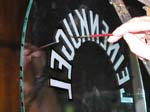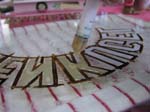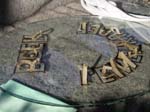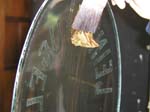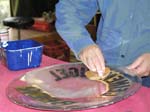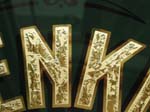Glue Chipped Glass
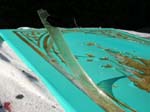
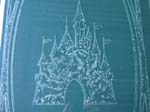
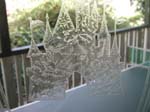 This intriguing technique uses hide glue or rabbit skin glue to chip off flakes of glass from
a panel leaving a fern-like chipped pattern. It has been used in stained glass windows and occasionally in signs since the early 20th century. Interest among signwriters has grown over the last couple of decades, partly due to the Letterheads movement.
This intriguing technique uses hide glue or rabbit skin glue to chip off flakes of glass from
a panel leaving a fern-like chipped pattern. It has been used in stained glass windows and occasionally in signs since the early 20th century. Interest among signwriters has grown over the last couple of decades, partly due to the Letterheads movement.
Glue chipped glass can be water gilded. Care will be required as it is easily rubbed off the high points. It will tend to have more breaks and require much more patching than usual. It may require an additional layer of gold for full coverage.
Oil gilding is easier although it doesn't produce the same beautiful reflections as a bright gild. It can also be silvered or chemically gilded using the related method known as angel gilding.
The basic method to produce it is:
- Sand blast or abrade the area of the glass to be chipped. This provides
some tooth for the glue. The area can be masked with an appropriate masking
film if a specific pattern is desired. Clean the glass, removing all residual powder from the sand-blasting.
- Spread glue to the required thickness on these etched areas. You need to keep the glue only on these areas. If you have already removed the sandblast mask, this can be achieved by painting asphaltum (bituminous paint) on the negative area which acts as a resistive barrier to the glue's tendancy to spread.
- If the mask is still in place, you may need to cut the extraneous glue away from the edge if it runs over the mask.
- Keep the glass panel in a warm place or in the sun and the chipping happens
as the glue dries over the next half a day. The glue shrinks as it loses
moisture content and chips off fragments of glass.
- Clean the glass. Asphaltum is cleaned off with Mineral turpentine.
Be careful of the fine sharp slivers of glass, some of which will be embedded in the dried glue. Keep away from animals as they may try to eat it.
- Gild or paint as required
I have tried several glues. Some rabbit skin glue can be fairly weak and others are excellent. I have also used "joiner's pearl" which works well. They can also be mixed together. In USA, there one called "5X hide glue" which is often recommended. All of them smell disgusting.
The glue is mixed at a ratio of 1:1 dry glue to water by volume. By weight it is 1:2, glue to water. The glue is made in the same manner you would use for glue size for gesso or woodwork. Heat (don't boil) in a double boiler or microwave, then spread to a thickness of 1-2mm. A thicker layer will create a larger chip pattern. Approximately 400gm glue/800ml water per square metre.
Here's a series of photos showing step by step using the asphaltum method.

